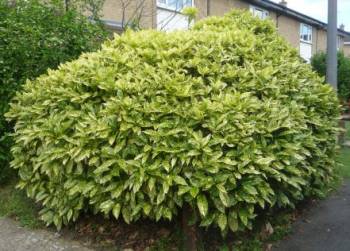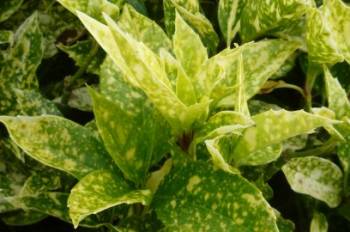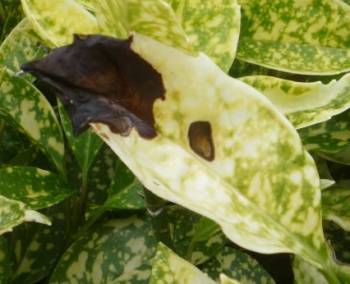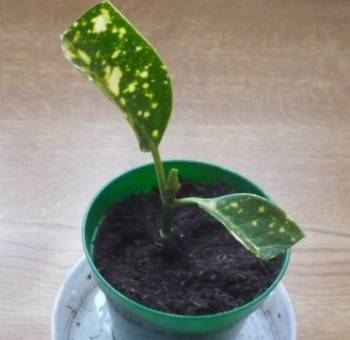SPOTTED LAUREL (AUCUBA)
Article by David Marks
The technical name for this shrub is Aucuba japonica. It is also known as the “Gold Dust Plant” in America. First bought to the UK in 1783, it only existed here as the female form. In order to produce the red berries a male form is required for pollination and this was duly bought to the UK in 1861. In Victorian and Edwardian times this was a very popular plant but has now become less favoured. It does have some very worthwhile features which make this a useful and attractive plant to grow in many gardens
This shrub is often under-rated principally because it was so widely grown. Several varieties of Aucuba japonica have been given a Royal Horticultural Society Award of Garden Merit, the most popular being Crotonifolia, Rozannie and Golden King. Of them all we would recommend Aucuba japonica ‘Crotonfolia’.
Use the checklist below to decide if a Spotted Laurel is suited to your preferences and garden conditions:


Spotted Laurel in a bush shape
- An evergreen shrub which, if not pruned, reaches a height of 3m / 10ft with a similar spread. The Spotted Laurel is a slow growing shrub increasing in height and spread at a rate of 20cm / 8in per year. It is easily pruned to shape and it makes a delightful rounded shrub.
- It is fully hardy in almost all areas of the UK withstanding temperatures down to -12°C. In a protected position it is hardy to a few degrees lower.
- This is well suited to even the laziest gardener! They grow well in all conditions except water logged soils.
- Aucubas thrive in full sun and full shade. In shade the leaves maintain their variegation well, bringing a dull corner to life.
- Once established, it rarely requires watering and will tolerate drought.
- A very versatile shrub, it can be grown as a specimen plant, singly in containers, as a hedge or against a wall / fence.
- Disease resistance is good with the minor exception of the occasional black leaf when grown in full sun. In most cases this is hardly noticeable and can be ignored. this is a “condition” and not a disease.
- All parts of the plant are mildly poisonous. The berries are also poisonous although they are very, very bitter and unlikely to be eaten by young or older humans.
- For some unknown reason the base of an Acuba is a very attractive hiding place for slugs and snails. The picture above is of a Spotted Laurel in our garden and one dose of slug pellets (or whatever alternative you prefer) in May time kills literally hundreds of this pest overnight.Note: not all slug pellets / slug deterents contain Metaldehyde, so look on the label if this is a concern to you.This can be a benefit rather than a problem because you know where the majority of snails and slugs will be hiding during the day. The slugs and snails do no damage at all to the Spotted Laurel.
HOW TO PLANT A NEW SPOTTED LAUREL
Follow the steps below to ensure your Spotted Laurel is planted correctly:
- This shrub can be planted in almost all light levels from shade to full sun. It grows quickest in full sun but that is really the only difference.
- If the soil is heavy or is not free draining add lots of well rotted compost to the area and dig it in well.
- It can be planted all year long if the soil is not frozen and you can water well when conditions are dry. Mid March to April and mid September to October are the best times to plant this shrub.
- Dig a hole twice the width of the rootball. Sprinkle in a handful of blood, fish and bone and work into the ground.
- Place the plant into the hole, filling in with soil so that it is at the same depth as was in the pot. Fill around the rootball and firm the soil down gently but firmly. Water well to settle the surrounding ground around the rootball.
CARE OF SPOTTED LAUREL
When established a Spotted Laurel will look after itself. It rarely needs watering except in severe drought and will grow quite happily on average ground without the need of additional feeds. Pruning is not required for the first five years. After that pruning every two or three years will keep it to size and shape.


For younger plants up to two years old, water if conditions become dry. A twice yearly feed with blood, fish and bone in spring and autumn will help it to establish a good root system. Keep the area around the base of the plant free from weeds and grass.
HOW AND WHEN TO PRUNE SPOTTED LAURELS
The frequency of pruning depends on the shape and size you want the plant to grow to. Without pruning, Spotted Laurels will grow quite happily and form a bush, sized about 3m / 10ft high and wide after fifteen years or so.
For those of you who prefer a smaller shrub then pruning can be done any time between March and mid May. We wouldn’t advise pruning after late July because the young shoots which appear after pruning may well be soft and easily damaged by early frosts. We would not prune these shrubs until they reach 5 or more years old.
Pruning is simply a matter of cutting the shrub back to shape and size. Prune the stems and avoid cutting the leaves. If you cut the leaves they will discolour at the edges although they grow through this after a year.
A commonly asked question is how far back can I prune an overgrown Spotted Laurel? They can be cut cut back very severely and in our experience they always come back. An out of control plant can be pruned back to 60cm / 2ft high. The best time to do this type of drastic pruning is in May time when the plant is growing strongly.
If you have any cut flowers in the house when you prune your Spotted Laurel, use the variegated leaves as foliage in the plant arrangement.
GROWING SPOTTED LAURELS IN CONTAINERS
A single Spotted Laurel will grow very happily in a large container. A diameter of 45cm or more is about right.Fill with either standard multi-purpose compost or a John Innes type loam. This shrub makes an ideal container plant for a dark corner because it grows slowly, thrives in low light levels and is virtually trouble free.

Picture courtesy of Paramount Plants
The plant should be fed monthly between mid March to mid August with a handful of blood, fish and bone. It will of course require regular watering. Wait each time until the top 3cm of the compost is dry and then water well.
Pruning is as described above although you may to prune more frequently to keep the plant to shape and an appropriate size for the container. It does help if the shrub is in a heavy container to avoid it easily being blown over.
PESTS AND DISEASES OF SPOTTED LAURELS
Spotted Laurels are one of the healthiest shrubs to grow in the UK. Occasionally they can suffer from blackening of a small number of leaves.
BLACK LEAF OF SPOTTED LAURELS
The key symptom of this problem are blackened areas on the leaves This occurs on plants which are grown in full sun. In the vast majority of cases the damage is insignificant.


Where the plant is only partially affected the solution is to remove blackened leaves as soon as they are noticed. Where the damage is more severe you have two choices:
- prune back hard in mid May, remove all the prunings and in all likelihood the plant will bounce back with new growth in a month or so.
- accept the fact that the position of the plant is the cause, dig it up and plant something there which can cope better. You may want to take cuttings before you do this, read our section below on propagation.
We have noticed that it is the sunny side of plants which are most affected.
HOW AND WHEN TO PROPAGATE SPOTTED LAURELS
Spotted Laurels are easy to propagate and the chances of success, even for very amateur gardeners, are very high. The following guidelines will ensure the best outcome:
- Take the cuttings in late July to early September time. If the bush is some distance away take a plastic bag to store the cuttings in and prevent moisture loss. Also, take the cutting longer than needed and make the final cut (see below) when you are ready to plant the cutting. This will minimise the cut healing over which makes rooting more difficult.
- Select a stem which is about 1cm thick and cut it off just below a leaf node to leave a 8cm / 3in cutting. The cutting should be semi-ripe which means not new soft growth and neither hard old growth. Somewhere in between is best.


The cutting unprepared
- Remove the lower leaves of the cutting. Don’t be afraid to cleanly cut the remaining leaves to reduce the leaf area.


Lower leaves removed
- Fill an 8cm wide pot with multi-purpose and insert three evenly spaced cuttings in it about 4cm / 1.5in deep.


Cuttings in a pot of compost
- Gently firm the compost down around the cuttings to ensure it is in good contact with the stem. You may want to take a couple of cuttings to ensure the best chance of success.
- Place the pot in a shallow tray / bowl of water for half an hour so that it absorbs a good amount of water but the top part is not water-logged.
- Remove the pot from the water and cover it with cling film or a small plastic bag and support it so that it does not touch the leaves. Plant markers are good for this purpose.
- Place the pot in a shaded and cool (but not cold) position.
The cuttings should begin to root in two to three weeks and at this point remove the plastic bag. The cuttings should then grow and the best time to plant them out in their final position is next April / May when the danger of frost has passed.
During that time keep the rooted cuttings in a cold greenhouse or outside in a shaded position out of the way of harsh weather. They may well need watering, keep the compost slightly moist but not waterlogged.
WHERE TO BUY SPOTTED LAURELS
Spotted laurel shrubs are available in varying stages of development from many garden centres and online plant suppliers. If you want to buy a single plant online we suggest that
Crocus is your best bet. They offer a five year plant guarantee, top quality plants and excellent service.
If you wish to buy in bulk however, for hedging, we would suggest Paramount Plants and Gardens or
Hedges Direct.
Other similar shrubs in this series include Ceanothus, Choisya, Hebe, Skimmia, Magnolia, Mahonia, Mock Orange, Lilacs, Potentilla and Rose of Sharon (hibiscus syriacus). For the full list, click the Shrub Index link below.
SPOTTED LAUREL SUMMARY
Below we list the key strengths and weaknesses of a Spotted Laurel.
| HARDY | |
| CLAY SOIL | Yes |
| SANDY SOIL | Yes |
| DRY SOIL | No |
| SHADE | Partial, full sun |
| EVERGREEN | Yes |
| EASY CARE | |
| SMALL GARDENS | Yes |
| POT / CONTAINER | Yes |
| FLOWERING | |
| FLOWER TIME | Berries (see article) |
COMMENTS / QUESTIONS LEFT BY OUR READERS
ANSWER: I would ignore them, they are not very noticeable and do no harm. It is perfectly normal and does not indicate a problem.
ANSWER: Unfortunately I don’t know from personal experience. But from what I have read they do produce suckers. Perseverance in cutting away the suckers is the only alternative to the massive task of removing all the roots. And from all accounts that perseverance might take five years or more.As I say though, I have never removed one myself.
could be the cause. Any ideas please?ANSWER: I’m no expert on this subject but my research indicates that Spotted Laurels (aucuba) are
only mildly poisonous to dogs. Unless a large amount was eaten it seems unlikely it would cause a seizure.The common laurel (and there are many different types) however, does appear to be significantly more poisonous and
a seizure after eating any part of the bush is quite likely. If you have any doubts, ask a vet.
the kitchen window. I’m now considering if I should plant them in a pot outdoors? Thanks!ANSWER: You could do that. But I would pot them into normal multi-purpose compost, water
it and then leave it on the kitchen windowsill for a month. Then put it outside in a sheltered position.
Is it true that aucuba poisons the ground
and nothing can grow in its place?ANSWER: As far as I am aware that is not true.
ANSWER: That’s a difficult question to answer with certainty because the state of the ground around the wall and in particular the foundations of the wall can be very different. In general terms though I have not heard of aucuba causing any problems.
WHY NOT LEAVE YOUR QUESTION / COMMENTS ABOUT THIS PAGE?
ENTER THEM BELOW. EMAIL ADDRESS IS OPTIONAL.
YOUR COMMENTS WILL BE ADDED ABOVE WITHIN A FEW HOURS.
[contact-form-7 id=”1882″ title=”Contact form 1″]